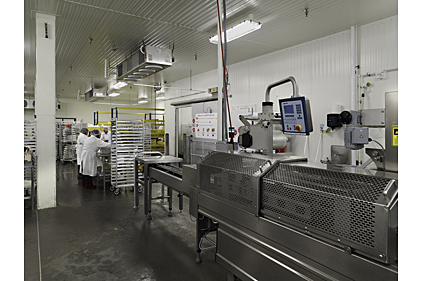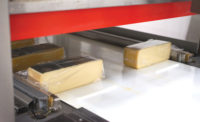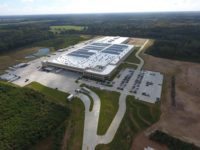The renovation or expansion of any type of production facility indicates a company is growing and prospering. Excitement and optimism builds as designs are completed, plans are approved, construction is commenced and equipment is ordered and installed. But, unlike other industries, the renovation of a food processing facility brings a unique set of concerns and challenges for facility owners and operators.
Whether it’s the installation of a new process line or the construction of a major expansion to increase production capacity, the challenges and concerns associated with renovating an operational food processing facility can seem numerous and overwhelming. Given the level of risk involved, food processing companies often struggle with finding solutions to the myriad of problems that can occur during a renovation process. But, if executed well, proper planning and management will greatly reduce, if not eliminate, the potential for problems during a renovation project. This requires a conscious effort by the entire project team to identify the problems that can arise, openly discuss the causes and potential impacts and then develop specific plans to manage and mitigate risks.
Food safety is paramount
As expected, industry experts cite food safety and sanitation as the most significant of their concerns. Jeff Tarantino, owner of CGA Consulting, Marshalltown, Iowa, has managed numerous renovation and expansion projects during his many years as a corporate engineer with companies such as Boar’s Head Provisions and Sorrento.
“The challenge prior to actual initiation of a renovation or expansion to an existing production facility is the identification of market opportunities, which will provide the intended goals desired,” Tarantino says. “But, during the renovation of a processing facility, the primary challenge is maintaining food product safety.”
For food safety to be truly implemented into a renovation project, it must be addressed at the initial planning phases of a project. Stuart Jernigan, director of pre-construction for A M King, Charlotte, N.C., has been involved with more than 50 food facility projects, including five that won the “Food Plant of the Year” award, awarded by Food Engineering, Refrigerated & Frozen Foods' sister publication.
“Food and personnel safety is what must be stressed from Day 1 of planning a food facility renovation,” Jernigan says. “By partnering with a firm that specializes in the planning of food facilities, owners can rely upon that firm to have a thorough understanding of the elements of food safety. On every project, we incorporate these elements into our design, and then into our construction practices.”
Addressing food safety during the planning process is key, according to Robert Shore, former partner and general manager of B. Robert’s Foods before the Charlotte, N.C.-based private label prepared foods manufacturer sold to Bakkavor in January. Shore and his partners expanded B. Robert’s Foods into a major food processor by planning and developing a new facility in 2010.
“Having never built a food plant before, we needed to rely upon industry experts to advise us on best practices,” Shore adds. “In regards to food safety, it was imperative that our team coordinate with and include the various regulatory representatives in the planning process.”
While incorporating food safety into the planning phases of a project is necessary, proper management and execution is equally important.
“Maintaining food safety is the most critical factor during construction,” Tarantino says. “To facilitate adherence, the owner must select a team that has demonstrated understanding and adherence to food safety procedures in past projects.”
But, the responsibility does not end with the construction team.
“In addition, the owner must provide written procedures to be followed during construction, as well as additional training as required on the specific issues related to the specific facility,” Tarantino says.
No disruptions to ongoing operations
Food facilities typically need to continue operations during a renovation project. Interruptions to production or reductions in output are concerns that every owner and operator face during these projects.
“The purpose of most renovations and expansions is to increase production required to keep up with product demand,” Jernigan says. “To interfere with the output of a facility, especially one that is already not meeting consumer demand is absolutely detrimental to a producer.”
For this reason, it is imperative for the project team to develop a logistics and scheduling plan that allows the renovation to proceed in an efficient manner, without interfering with ongoing production operations.
“Absolutely detailed planning and execution” is necessary, Shore says. This requires an open level of communication between the design team, the construction team and the operations team in a facility.
“A continuous proactive relationship must be developed to maintain awareness of current project status as well as anticipation of potential issues,” Tarantino says.
This means that the project team must develop a process to communicate regularly, and that no team member, either from the owner, operator or construction side, can make assumptions about any others’ work or expectations.
It is also imperative that each individual on the project team realize that they have a responsibility to develop an understanding of and respect for the expectations and goals of the other parties. According to Shore, the design team and construction team “need to be engaged during the total process.” In return, the owner/operator must “hire responsible people to manage the minute-by-minute operations of the food facility, and yet be available to follow the process” developed by the project team.
“Without a doubt, the best food facility renovations occur when the entire team is engaged, communicating in an open and honest manner and developing a high level of respect for each other’s objectives,” says Jernigan.
However, food production and construction share a similar trait in that things can change at a moment’s notice. Therefore, anticipating and planning for these situations is key.
“Alternatives must be developed to minimize or eliminate anticipated issues,” Tarantino says.
“We try to anticipate everything that can go wrong, and then put a plan in place that is not only preventative, but will also minimize impact if these things do occur,” Jernigan adds. “It’s amazing when you take this approach how few problems actually do occur.”
Cost control and maintenance
It’s no secret—food facility design and construction can be expensive. But, when entering into a food facility renovation, there can often be unknown and unanticipated tasks that may escalate the cost. Practically every owner that has undertaken a renovation project worries that the estimated price provided at the onset of a project will be significantly less than the actual cost at the end of the project.
“The single greatest factor for developing accurate costs and then maintaining budgets for a food facility renovation is to utilize a design and construction firm that specializes in this type of work,” Jernigan says. “Using a design or construction firm inexperienced in the food processing sector may appear to provide a low-cost solution at the onset, but the problems and the cost will steadily rise during the project duration. In my more than 25 years of food facility projects, I can say that I have never seen the selection of an inexperienced team lead to a successful project.”
“We hire experts that we can rely upon, and then we often compare their answers to other reliable sources in the industry,” Shore says.
By taking the approach of using only industry experts, a food facility owner will have greater confidence that not only is the pricing accurate, but also that possible cost increases were anticipated, discussed and even accounted for in the budget process.
While accurately budgeting and controlling costs in a food facility renovation are important, there is another cost factor to consider—the evaluation of equipment, materials or enhancements that may increase production.
“Increased costs associated with these improvements must be weighed against long-term impacts,” Tarantino says. “Construction materials can improve sanitation and maintenance or reduce required manpower. Mechanical and electrical system improvements can reduce usage or maintenance of the systems.
During the planning process, an experienced design and engineering team can offer suggestions and cost information for specific materials, equipment or systems for consideration and evaluation by the owner. This information would not only include initial costs, but also the potential life-cycle cost savings related to energy, labor efficiencies or reduced maintenance.
“We understand our role as experts in the industry, and therefore we need to stay abreast of improved systems or equipment that an owner may want to consider while under renovation,” Jernigan says. “We can provide the information they need to make informed decisions for the future of their business.”
While a renovation project may only take a few months, the owner and operator will most likely live with the outcome of the renovation for many years.
“The assumption must be made that a renovation or expansion of a facility indicates a long-term strategy rather than a short-term payback,” Tarantino adds. “If long-term strategies are assumed, improved quality implementation can be evaluated effectively with consideration given to cash flow availability.”
Understanding roles and responsibilities
Planning, teamwork and communication are all necessary for the successful execution and delivery of a food facility renovation. But, for it all to come together, it is important that each team member have an understanding of the others’ project expectations.
“I expect the design, building and installation teams to have a strong foundation in the food industry,” Tarantino explains. “This team should have the ability to provide alternative solutions, anticipate concerns and potential issues and meet project schedules and cost budgets.”
Likewise, the design and construction teams have a level of expectation of the facility owner.
“The owner should have a project representative that has knowledge of the facility, knows the production process and has a clear understanding of the goals and expectations of facility operations,” Jernigan says. “By having a singular point of responsible contact from the owner, the communication channels are clear, and we can better coordinate our work with the facility operational team.”
You don’t know what you don’t know
Arguably, the renovation of an operational food processing facility presents a greater set of challenges and concerns than practically any other facility type. Ensuring food safety, maintaining operational production and managing project costs and schedule are just a few of the areas that require attention and focus from the project team.
But, in the end, it’s the quality and expertise of the project team that will ultimately provide for a successful project.
“You don’t know what you don’t know. Ask a lot of questions. You will get many opinions about detail, and each detail can lead to positive or negative results,” Shore says.
“There’s a lot that goes into the successful delivery of a food facility renovation,” Jernigan adds. “But, when the right team is in place, and the team members actively focus on meeting the challenges and concerns head on, the probability for success is extremely high.”



